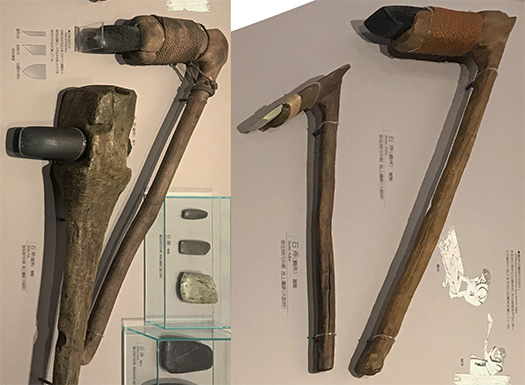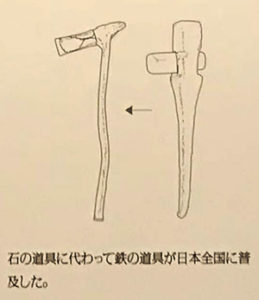


縄文時代と弥生時代の「砦」のような高層建築を見てきたけれど、
いずれにせよ、その復元について確かなエビデンスは難しい。
状況証拠を丹念に探究していくしかないというのが科学の立場でしょう。
その建築道具として、斧というのは始原的存在であることは理解出来る。
人類の船の利用は、水辺という絶対必要環境で流木などが水に浮かんでいるのを見て
「あれに乗ることができれば・・・」と類推したに相違ないことを考えても
ごくごく始原的な動機に起因するだろうと思われる。
現生人類は「好奇心」において他の先行人類をはるかに超えていたと言われる。
群の中から、その流木にしがみついて遠隔地に出掛けて
また水の「流れ」を利用して帰還するなり、テリトリーを拡大する手段に
やがて採用することはごく自然に体得していったことは疑いがない。
ひょっとすると人類の「体毛の減少」とすら関係しているかも知れない。
最初期に石という「道具」を発見したときに、木という素材に対して活かすのは
これもまた人類史的な「進化」だったことも間違いない。
人類史のスタート時点からこうした進化方向は選択されていたと思える。
そういった人類がグレートジャーニーという世界各地への進出を果たすとき、
木に対して石を使って「船」として利用する加工技術は始原的だった。
その起源的な道具として「石斧」はあった。
自然にある固い樹種の枝を採取し、その切っ先に鋭利な石を加工すれば
木を切り倒して利用することが可能になる。
次に真ん中部分を「くり抜く」ことで木の上で安定的体動作が可能になるという
技術進化の流れは、動機も含めて自然なものだと思う。
アフリカから中東地域、そこで枝分かれしてヨーロッパ大陸に向かった一群と
ユーラシア大陸に拡散したグループに分かれたけれど、
ひとつはオーストラリア大陸に向かって他の人類とは道を異にした。
このひとびとも分かれるときに船を利用しただろう。
そしてわれわれアジア大陸に向かった一群はその最東端であった台湾から
日本列島の最西端地域に向かってフロンティアの「船出」をした。
3万年前、日本列島進出の経緯を想像したNHK番組で語られたテーマ。
もちろんエビデンスは完璧ではないけれど、蓋然性はきわめて高いと思う。
このような日本列島への人類進出と同時並行で「船を扱う」ことは
目的的に追究されたと考える方が自然ではないか。
この列島に来着してみると、周囲を海に囲まれて気候風土的に
格別な環境として豊かな森林資源があることは容易にわかったことだろう。
来着するのに木の船を利用してきた人々にとって、
この環境の中で「船大工」技術が「家大工」技術を生み出したことも自明。
そしてやがて1万年前の縄文の世、巨大柱穴が6つ残された木造構築物に至った。
石器時代由来の人類知の巨大集積「石斧」が縄文の建築を可能にした。
石斧はこのような発展経緯の中で「縦斧」と「横斧」に仕分けられた。
縦斧は「木を切り倒す」目的性が高く、
一方の横斧は木をくり抜くような用途合理性が高く、
次第に木を加工する仕上げ的道具として多様な発展を遂げていった。
手斧という形態で、より細かな仕事を可能にしていっただろう。
継ぎ手仕口という、木造進化の独自性がいつの時代から可能となってきたのか、
非常に深く刺激を受け続けております。
現代の建築史、建築学の総力を挙げての遺跡復元という探究成果に
それらは反映されているだろうと、わたしとしては受け止めております。
English version⬇
[Human history and building tools “Stone Ax” / Good Japanese house ㊳-3]
I’ve seen high-rise buildings like “forts” in the Jomon and Yayoi periods,
In any case, there is difficult solid evidence for its restoration.
The position of science is that there is no choice but to carefully explore circumstantial evidence.
It is understandable that the ax is a primitive existence as the building tool.
When using a human ship, see driftwood floating on the water in the absolutely necessary environment of the waterside.
Even if you think that you must have analogized “If you can ride that …”
It seems to be due to a very primitive motivation.
Modern humans are said to have far surpassed other predecessors in “curiosity.”
From the group, cling to the driftwood and go to a remote place
Also, as a means of returning home using the “flow” of water, it can be used as a means of expanding the territory.
There is no doubt that it was quite natural to adopt it in due course.
Perhaps it is even related to human “hair loss”.
When you first discovered a “tool” called stone, what you can use for the material called wood
There is no doubt that this was also an “evolution” in human history.
It seems that these evolutionary directions have been selected since the beginning of human history.
When such human beings make a foray into various parts of the world called the Great Journey,
The processing technology of using stones for wood as a “ship” was primitive.
There was a “stone ax” as its original tool.
If you take a branch of a hard tree species in nature and process a sharp stone on the tip
It will be possible to cut down trees and use them.
Next, by “hollowing out” the middle part, stable body movement is possible on the tree.
I think the flow of technological evolution is natural, including motives.
From Africa to the Middle East, where a group of branches headed for the European continent
Divided into groups that spread throughout the Eurasian continent,
One turned away from the rest of humanity towards the continent of Australia.
I would have used a ship when these people were separated.
And we, the group heading for the Asian continent, came from Taiwan, which was the easternmost point.
We made a frontier “departure” toward the westernmost region of the Japanese archipelago.
The theme told in an NHK program that imagined the process of expanding into the Japanese archipelago 30,000 years ago.
Of course, the evidence isn’t perfect, but I think it’s very likely.
“Handling a ship” at the same time as the advance of humankind into the Japanese archipelago
Isn’t it more natural to think that it was pursued for the purpose?
When you arrive at this archipelago, you will be surrounded by the sea and the climate will be
It would be easy to see that there are abundant forest resources as a special environment.
For those who have used wooden boats to arrive and arrive
It is also self-evident that “ship carpenter” technology created “house carpenter” technology in this environment.
Eventually, in the Jomon period 10,000 years ago, a wooden structure with six huge postholes left was reached.
A huge collection of human knowledge from the Stone Age, “Stone Ax,” made it possible to build Jomon.
The stone ax was classified into a “vertical ax” and a “horizontal ax” in this development process.
The vertical ax has a high purpose of “cutting down a tree”,
On the other hand, the horizontal ax is highly rational for use like hollowing out a tree.
Gradually, it has made various developments as a finishing tool for processing wood.
In the form of a hatchet, it would have enabled more detailed work.
When did the uniqueness of the evolution of wooden structures, called joint fittings, become possible?
I continue to be very deeply stimulated.
For the results of the quest to restore the ruins with all the power of modern architectural history and architecture
I accept that they will be reflected.
Posted on 8月 2nd, 2021 by 三木 奎吾
Filed under: 住宅マーケティング, 歴史探訪







コメントを投稿
「※誹謗中傷や、悪意のある書き込み、営利目的などのコメントを防ぐために、投稿された全てのコメントは一時的に保留されますのでご了承ください。」
You must be logged in to post a comment.